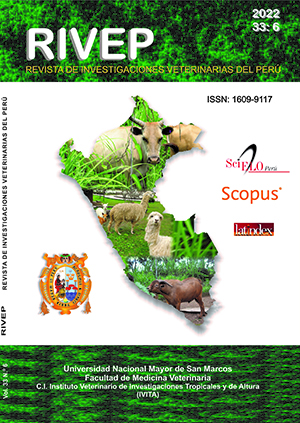Cryopreservation of spermatozoa of llama obtained from the vas deferens using three freezing curves
DOI:
https://doi.org/10.15381/rivep.v33i6.24099Keywords:
cryopreservation, spermatozoa, motility, llama, temperatureAbstract
The aim of this study was to determine the effect of three freezing curves on the post-thaw viability of spermatozoa collected from the vas deferens of llamas. Six male llamas with surgical diversion of the vas deferens were used. The samples of the six males were mixed for processing (pools) and diluted with Tris-egg yolk. Cooling was carried out to 5 °C where the dilution was completed (dilutor with glycerol) and was maintained for 30 minutes (equilibrium phase). Samples in 0.25 ml straws were subjected to freezing using a temperature drop rate of -20°C/min until reaching -80°C (TI), -100°C (TII) and -120°C (TIII) in 4, 5 and 6 minutes, respectively, to finally store them in liquid nitrogen. The samples were collected for three months (n=19 pools). Total motility (progressive, circular, oscillatory motility), viability and membrane functionality were determined after collection, in the equilibrium phase and upon thawing. A significant decrease (p<0.05) was observed in all the sperm characteristics evaluated in the samples after the equilibrium compared to the samples after collection. A high positive correlation was obtained between viability and total motility (r2=0.78) and in the equilibrium phase between membrane functionality and total motility (r2=0.881). In thawed samples, total motility and viability were significantly higher in frozen samples. with the freezing curve TIII with respect to TI (p=0.041 and p=0.003, respectively). No significant differences in membrane functionality were observed between the three freezing curves (p>0.27). In conclusion, the temperature drop curve down to -120 °C using a rate of -20 °C/min would be the most suitable for cryopreserving llama spermatozoa obtained from the deviation of the vas deferens.
Downloads
Downloads
Published
Issue
Section
License
Copyright (c) 2022 Manuel Pérez D., Carlos Bustamante Q., Italo Coronel U., María Ignacia Carretero, Yan Manrique Q., Eloy Condori C., Uri Perez G.

This work is licensed under a Creative Commons Attribution 4.0 International License.
AUTHORS RETAIN THEIR RIGHTS:
a. Authors retain their trade mark rights and patent, and also on any process or procedure described in the article.
b. Authors retain their right to share, copy, distribute, perform and publicly communicate their article (eg, to place their article in an institutional repository or publish it in a book), with an acknowledgment of its initial publication in the Revista de Investigaciones Veterinarias del Perú (RIVEP).
c. Authors retain theirs right to make a subsequent publication of their work, to use the article or any part thereof (eg a compilation of his papers, lecture notes, thesis, or a book), always indicating the source of publication (the originator of the work, journal, volume, number and date).










